Table of Contents
This being the issue which is distributed at our Annual Dinner Meeting, and our speaker on that occasion taking as his subject "Lake Ontario and the Founding of Toronto", it seems only appropriate that we feature in these pages not one but two of the steamers which for many years were favourites on the Toronto waterfront. The Toronto Island ferries have long been popular amongst the residents of this city, for whom they have provided welcome respite from the heat of the summer, and for this reason we have presented, over the years, the stories of a number of vessels that have served the Island route.
The Island ferries have been widely disparate in design, and well over one hundred vessels of various types are known to have operated regularly in this trade since the horseboat SIR JOHN OF THE PENINSULA first began running in 1833. (The Islands then were not even islands but rather a long peninsula stretching westward across the harbour and formed from detritus pushed westward from the Scarborough Bluffs by the long-shore drift of Lake Ontario.) There have been horse-powered ferries, steamers and diesels, and even a cable-ferry; there have been large boats and small, sidewheelers and propellors, double-enders and single-enders, side-loaders and end-loaders, and even ferries which could load on both the main and upper decks at the same time (Metro Parks and Property Department please note).
But regardless of the fact that larger vessels such as the big double-ended sidewheelers MAYFLOWER and PRIMROSE had been running on the Bay since 1890, joined in 1906 by BLUEBELL and in 1910 by TRILLIUM (today's only survivor of the glory days of the ferry service), the most popular ferries were the smaller steamers with which the travelling public more readily could develop a personal affinity. One of the poems in a small book entitled The Island, by Estelle M. Kerr, which was distributed at Christmas one year early in the century by Lawrence J. "Lol" Solman, long the principal of the Toronto Ferry Company, stated in part:
"The Island fathers then, who missed
The single morning boat, must row,
But two boats plied each afternoon;
Perhaps they were a trifle slow,
But how we loved them in our youth,
And friendly, greasy engineer -
Yet who would sing her praises now?"
Yes, LUELLA was one of the most popular of all of the smaller ferries and she sailed the Bay for 56 seasons, beginning in 1880. Of the same general type were ARLINGTON, MASCOTTE, JESSIE L. McEDWARDS, ADA ALICE and ELSIE, all of which ran in the turn-of-the-century period and also were single-decked vessels. Slightly larger and (at least latterly) double-decked steamers were ferries like GERTRUDE, CLARK BROS., JOHN HANLAN, KATHLEEN and ISLAND QUEEN.
Why in particular have we chosen the latter two for this feature? Well, it so happens that this year marks the 70th anniversary of the last season of service for both ISLAND QUEEN and KATHLEEN. As well, the early years of ISLAND QUEEN were such as to lead to the perpetuation of faulty information concerning her, and mystery has for many years surrounded the eventual demise of both steamers, in that it was generally thought that they perished in a fire which, as we now know, did not even involve them. Adding to the mystery shrouding the two vessels has been the peculiar fact that, although they served on the Bay for some three decades each and lasted well into the new century, only a few photographs, none of them of exceptional quality, are known to have been taken of ISLAND QUEEN and, until very recently, no photos could positively be identified as illustrating KATHLEEN.
All that has now changed, and at this point in time we probably know as much about ISLAND QUEEN and KATHLEEN as we ever will. We also have several identifiable photos of each steamer. In later years, the two ships were rebuilt in such a manner that they were almost sisterships, and we have finally discovered how to tell them apart. If only turn-of-the-century historians and photographers had paid more attention to these much-loved and hard-used belles of the Bay, we would today be able to present an even more detailed history of their careers.
ISLAND QUEEN has been a popular name for passenger vessels and there have been at least five steamers of that name on the Canadian register, plus numerous more recent motorvessels. Depending upon how one views the situation, there have been either two or three vessels named ISLAND QUEEN on Toronto Bay. The first was a wooden ferry steamer of 70 tons, 88.0 x 10.0 x 6.0, which was built at Kingston in 1845 for service between Kingston, Garden Island and Wolfe Island. She was running the Toronto Island ferry service in 1855, and by 1868 she was gone from Canadian registry, disposition unknown. She never was assigned an official number.
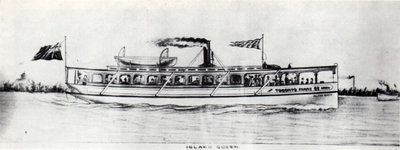
Gibbons' 1904 drawing of ISLAND QUEEN is the only known view of the steamer before she was completely rebuilt during the winter of 1904-1905.
The ISLAND QUEEN with which we are concerned was a wooden-hulled, single-ended propellor, which was built at Toronto in 1889 by A. Lavallee and Joseph Duval, enrolled as C.92738. Some records state that the steamer was constructed at Port Dalhousie but any such suggestion is clearly in error. The new vessel was 73.0 feet in length, 13.9 feet in the beam, and 4.4 feet in depth, with tonnage of 23 Gross and 20 Net. (Her beam has variously been reported as 14.0 feet and her depth as 5.0 feet.) She was powered by a high-pressure, non-condensing engine with a single cylinder of 9 inches diameter, and a stroke of 12 inches. The engine was built by Beckett & Company of Hamilton, its Nominal Horsepower variously recorded as 14 or 16. Indicated Horsepower was 140 at 120 revolutions per minute. Steam at 115 p.s.i. was produced by a single firebox boiler, 4 feet by 6 feet, which was built for the steamer by Polson Iron Works, Toronto. The 1899 "Great Lakes Register" indicates that the boiler was built in 1890, but we suspect that this entry may be in error, as it is unlikely that the steamer was reboilered in only her second year. The other possibility is that the hull of ISLAND QUEEN may have been built in 1889, but her machinery not installed and the steamer commissioned until 1890.
ISLAND QUEEN could accommodate 148 passengers; at least, that is the number for which she was licensed, but we suspect that on days of heavy passenger movement, a few more might well have found their way aboard. Her single deck was covered by a shade deck from stem post to fantail and the forward end of the main deck was open at the sides. There were a few seats for passengers in this area surrounding a small clear spot where the steering wheel was located and from whence the steamer was navigated (in much the same manner as was the little LUELLA until her retirement at the close of the 1935 season). There was only one passenger gangway on each side, and it was located at the after end of this open forward area.
The main cabin, such as it was, was located amidships and it sported eleven large, round-topped windows on each side. The passengers sat on wooden benches which ran down the sides of the cabin facing in toward the engine area, with the cylinder head and controls in full view of everyone (much to the delight of small children). At the fantail was a small open area which served not only as observation deck but also for the crew to secure the aft mooring lines..
On the upper deck (in other words, atop the cabin) was located little except a long clerestory, from which sprouted the steamer's short and rather thin smokestack. There was a short flagstaff at the forward end of the skylight and, of course, a taller one aft. The single lifeboat was carried on top of the clerestory, aft of the stack. There were no passenger facilities of any nature on the upper deck and passengers had no access to this area.
ISLAND QUEEN was originally built for A. J. Tymon's Island Park Ferry Company, which was one of several concerns which operated ferry services to various points on the Island from the city. However, on April 2, 1892, the Island Park Ferry Company was taken over by the Toronto Ferry Company Limited, which had become the dominant ferry operator on the Bay, and which would continue to run the ferry service until the end of the 1926 season. As well, the Toronto Ferry Company would control the amusement park at Hanlan's Point (at the westerly end of the island chain), including the baseball stadium at which the Toronto Maple Leafs of the International League played for many years.
In September of 1889, prominent Torontonian E. B. Osler, in partnership with others, had begun to negotiate for the purchase of the Doty Ferry Company, which had been operating on the Bay for many years. The acquisition was completed and, on February 27, 1890, the Toronto Ferry Company Ltd. was registered as a joint stock company capitalized at $250,000. Its principals were E. B. Osler, William Hendrie, F. W. Doty and Henry Beatty. By 1905, the company had increased its capital stock to $600,000 and, in that year, H. S. Osler, Britton Osler, William B. Raymond, D'Alton McCarthy and Frank Ford were elected to the board of directors. In 1906, R. A. Smith was also a director. Longtime manager of the Toronto Ferry Company was Lawrence J. Solman who, in later years, acquired complete control of the firm.
We have no idea what ISLAND QUEEN's colours may have been when she was operated by A. J. Tymon. However, when she joined the Toronto Ferry Company's fleet, her hull was white and the rubbing strake at main deck level was black. Her name appeared in small black letters on the bows above the strake and in a fancy scroll-type setting on the closed rail at the fantail. The main deck rail was white and the company's name appeared in large black letters, with fancy coloured shading, on the rail near the bow (just as TRILLIUM still carries it, except that the shading of the letters today is grey). Pinstriping, probably in black, made the main deck rail appear as though it had been constructed in panels, even though such was not the case. The cabin sides above the rail (around the windows) and the stanchions on the foredeck were of a darker colour, but contemporary views of the fleet's steamers lead us to believe that these areas were not painted, but rather stained and varnished.
The Toronto Ferry Company operated a number of services to the Island, with departures at various times from Yonge Street, Bay Street, Brock Street and Dufferin Street. In the early years, the most popular destination on the Island was Hanlan's Point, but ferries also operated to Island Park (the picnic area situated on Meade's Island, connected by bridge to Centre Island). Both Hanlan's Point and Centre Island boasted hotels and large populations of summer residents who had established themselves in elegant Victorian-style cottages along the lakeshore. Ferry service was also provided to Ward's Island, where the Wiman Baths were located, and where a summer tent community had begun to establish itself.
ISLAND QUEEN apparently operated on the various Toronto Ferry Company routes until 1904, when she went out of service. Some reports indicate that she may have suffered fire damage during that season. It can be supposed that ISLAND QUEEN did run in 1904, for accompanying this feature is a reproduction of a painting of ISLAND QUEEN done by the famous Toronto Harbour artist Charles I. Gibbons, dated 1904. Gibbons painted (or rather produced in watercolour, pencil, charcoal, crayon, or whatever was available) extremely detailed views of almost all of the renowned Toronto ships of that period, often in return for some appropriate "consideration" by the master of each vessel, and his sketches usually were done from life. We must therefore assume that ISLAND QUEEN operated during at least a portion of the 1904 summer season, before being retired.
Be this as it may, a "new" ISLAND QUEEN was built for the Toronto Ferry Company in 1905 at Bronte, Ontario. Enrolled at Toronto as C.117078, she was an oak-hulled, single-ended propellor, 97.8 feet in length, 20.3 feet in the beam and 5.4 feet in depth, 129 Gross and 88 Net. Despite the fact that this vessel was documented as a new ship, there seems little doubt that she was nothing more than a much-rebuilt, lengthened and widened version of the earlier ISLAND QUEEN, apparently fitted with exactly the same machinery as had been the older steamer. Contemporary press reports seem to make no distinction between the steamers and this undoubtedly is because the work was done over the winter of 1904-05, and everyone just assumed that the vessel had simply been "modernized" in the course of an extensive rebuild.
But what a reconstruction! ISLAND QUEEN emerged from the Bronte shipyard as a double-decker with considerably more cabin space and a new promenade deck. The main deck was of generally the same design as before, but with more space. The forward area was still open at the sides and, with the removal of the steering position from this location, increased seating was provided atop wooden floats. Then there was the closed cabin, and again a small open area at the fantail. However, there were now two passenger gangways on each side, one roughly in the same spot as before at the aft end of the forward open deck area, and the second (without hinged gangplank) approximately half-way down the cabin. There were six large, round-topped cabin windows forward of the aft gangway, and eight more windows abaft it.
Inside the forward section of the closed cabin was located the boiler, housed out of passenger sight. Abaft the boiler was the open engine area, with the cylinder head and controls still visible to the passengers, the engineer being positioned just below and slightly forward of the stairs that led up to the upper deck. A row of bench-seats ran down each side of this part of the cabin, facing inboard. In the aft part of the cabin, back of the second gangway, the benches again ran down each side, and a double-sided, high-backed seat was situated in the central area.
The upper deck was completely open for passenger use and consisted of an entirely open area forward, with a shade deck covering the area abaft the pilothouse. Wooden slat seats ran all the way around the deck rail, facing inboard, and a couple of benches back-to-back and facing outboard ran back from the bow. The rest of the seating both fore and aft on the upper deck was comprised of park-type benches set athwartship. The upper deck rail was built of wooden posts with wire mesh and a narrow handrail. A rather large sign, mounted prominently on the front of the pilothouse, reminded passengers that "The LAW FORBIDS You to Sit on The RAIL, it's DANGEROUS" (sic).
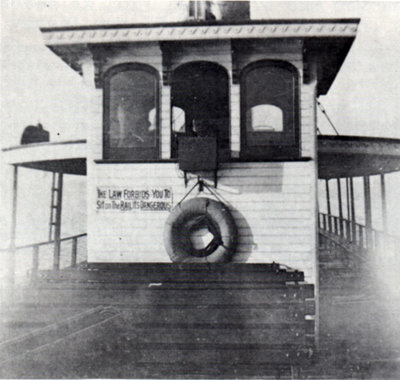
This interesting view, facing aft on ISLAND QUEEN's upper deck, was taken about 1910 by Rowley W. Murphy.
The pilothouse was a prominent, squarish structure, raised above the open deck and surmounted by a wide brow formed by an outward extension of the roof on three sides, the brow being decorated with rather intricate wood-carving that was peculiar to this steamer. There were three large, round-topped windows in the pilothouse front, with curved brackets between the windows to support the brow, and there was one large and one small window and a door in each side of the house. ISLAND QUEEN's binnacle was nothing more than a compass set in a box which was hung out the centre window of the pilothouse, there being so very little room inside. In fact, we tend to believe that ISLAND QUEEN was the first Toronto ferry to be given a pilothouse of this particular design, although the square cabin with the wide brow was to become something of a Toronto Ferry Company trademark, in that KATHLEEN, CLARK BROS. and JOHN HANLAN would all be rebuilt with similar pilothouses.
The shade deck was attached to the back of the pilothouse, and covered the full after end of the upper deck. Its edge all around was decorated with the same sort of fretwork that appeared on the pilothouse brow. The only enclosure of any sort in this area was the small wooden stack casing just abaft the pilothouse. The stack itself was tall and rather thin, but with a bit of rake to it. The single lifeboat was set on the hurricane deck abaft the funnel, worked from radial davits on the starboard side. A second lifeboat, placed on the port side, had been added by 1912.
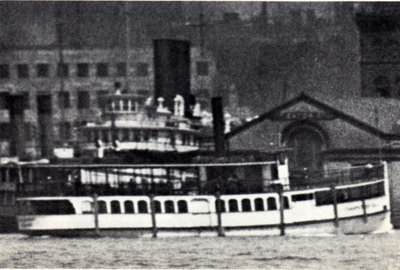
This interesting view, facing aft on ISLAND QUEEN's upper deck, was taken about 1910 by Rowley W. Murphy.
ISLAND QUEEN sported a tall steering pole at the stem, and a long flagstaff aft, but she carried no masts at all. In fashion typical of the small ferries of her day, her running light was set on a small wooden post mounted atop the pilothouse. The sidelight brackets were placed at the forward end of the sides of the shade deck. Of course, the navigation lights, as well as those in the cabin, were oil lamps, for neither ISLAND QUEEN nor KATH-was ever equipped with electric light. (In fact, as far as we know, the only one of their contemporaries amongst the smaller ferries that ever was fitted with a generator was CLARK BROS., and then only in the very last few years of her lifetime.
During her latter years with the Toronto Ferry Company, ISLAND QUEEN was painted white, both hull and cabins. Her decks were grey and her stack was all black. The trim around her windows and on the stanchions forward on the main deck was dark brown, as were the seats on both decks. The upper deck stanchions, the handrail and the safety floats were dark green. (These colours were changed somewhat in the later years of the T.F.Co.'s existence, but not until after ISLAND QUEEN had passed from the scene.)
ISLAND QUEEN remained in service into the years of the First World War and, although her hull had begun to hog somewhat, she undoubtedly would have had a few more years left in her. At this time, she and KATHLEEN normally ran to Centre Island, holding down the service themselves in times of light passenger movement, and augmenting the big double-ended paddlers in times of peak traffic. It has been said that ISLAND QUEEN was slightly damaged by fire in 1917, but we have been unable to ascertain any details of this occurrence, and we assume that damage was minimal and was soon repaired. Regardless, however, 1917 was to be ISLAND QUEEN's last year of service, for she had been reduced to ashes before the 1918 season began.
Unlike ISLAND QUEEN, KATHLEEN was built as a double-decked steamer. An oak-hulled, single-ended propellor, she was constructed at Toronto in 1886 by George Dickson. Enrolled at Toronto as C.90574, she was 84.0 feet in length, 18.0 feet in the beam, and 5.5 feet (sometimes reported as 6.0 feet) in depth. Her tonnage was 110 Gross and 72 Net. Her high-pressure, non-condensing engine was built by Nagle and Weed at Buffalo and had one cylinder of 12 inches diameter, and a stroke of 14 inches. Nominal Horsepower was listed as 35, while Indicated Horsepower was 100 at 140 revolutions per minute. Her one scotch boiler, 5'0" by 7'6", was built by Currie at Toronto and produced a working pressure of 85 p.s.i.
KATHLEEN also was built to the order of A. J. Tymon for his Island Park Ferry Company and, like ISLAND QUEEN, she passed into the control of the Toronto Ferry Company on April 2, 1892. The oldest identifiable photo of KATHLEEN (which we only recently have discovered) is a Micklethwaite view taken on June 27. 1893, and it shows KATHLEEN, with a large group of excursionists on board, amidst the Columbus Caravels, which had stopped over briefly in Toronto en route from Spain to the Columbian Exposition at Chicago. Although KATHLEEN is seen only from a distance, the photo does give us a good idea what she looked like, and it is evident that she did not change much between 1893 and the time that C. I. Gibbons drew her in 1904.
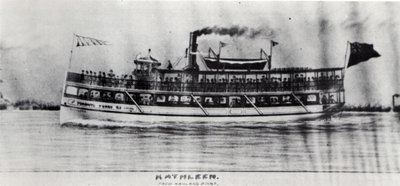
This 1904 rendering of KATHLEEN by Charles I. Gibbons shows the ferry steamer as she originally appeared.
In fact, KATHLEEN did not change much at all over her lifetime. As built, she looked much like ISLAND QUEEN did in the latter's sunset years, except that KATHLEEN originally sported an elaborately decorated (and apparently stained and varnished) octagonal "birdcage" pilothouse, complete with dome and finial. The compass, as might be suspected, was hung outside the centre pilothouse window even at that stage. KATHLEEN carried but one lifeboat, which was set on the port side of the hurricane deck, suspended from old-fashioned, gaff-type davits.
As the years passed, KATHLEEN received very little reconstruction, although sometime in the new century she was given the typical Toronto Ferry Company square pilothouse with a wide brow formed by the overhang of the pilothouse roof. Also, by 1912, she had received a second lifeboat, placed on the starboard side, and both boats were now worked by more modern radial davits.
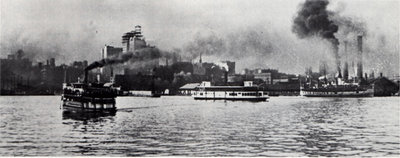
A 1912 photo caught KATHLEEN (left), TRILLIUM and DALHOUSIE CITY on Toronto Bay near the Bay Street ferry docks.
Now that we have managed to locate a reasonable assortment of photos of both ISLAND QUEEN and KATHLEEN, we have been able to ascertain ways of telling the near-sisters apart as they appeared in their later years, for the slight difference in size between the steamers is not readily apparent in any photos. KATHLEEN had one less window on either side of the main cabin abaft the after gangway than did ISLAND QUEEN, and KATHLEEN'S stack was somewhat shorter than that of her near-sister. KATHLEEN had a much taller steering pole, and both it and her flagstaff were topped with a small ornamental hall, which ISLAND QUEEN did not have. Perhaps the most obvious difference, however, now that we are aware of it, lies in the fact that the windows in KATHLEEN'S pilothouse were square-topped, whereas ISLAND QUEEN retained her curved-top windows right up until her demise. KATHLEEN did not have the fretwork on the edges of the pilothouse brow or shade deck that ISLAND QUEEN sported.
Like ISLAND QUEEN, KATHLEEN enjoyed a relatively accident-free life, considering the busy waters on which she operated. She did, however, sustain some fire damage whilst she was lying at the Toronto shipyard of Medlar and Arnott on October 12, 1912. Fortunately, she was out of commission for the winter season when the fire occurred, and there was no difficulty in rectifying the damage in time for the commencement of the 1913 season.
By this time, KATHLEEN was licensed to carry 200 passengers. She spent most of her time on the Centre Island route at this period, as did ISLAND QUEEN, but the two steamers occasionally were diverted to charter or excursion service when such business was available. A good example of this can be found in the very rare photograph which accompanies this feature, and which shows KATHLEEN and the Navy League's unofficially-named training barge COMMODORE JARVIS, the former steamer GATINEAU (91), (b) PAUL SMITH (02), (c) VALLEYFIELD, lying at the pier of the Royal Canadian Yacht Club. The original, small, privately-taken print is dated September 1917 and, judging by the crowds on both vessels and the dock, we suspect that the photo was taken on Labour Day.
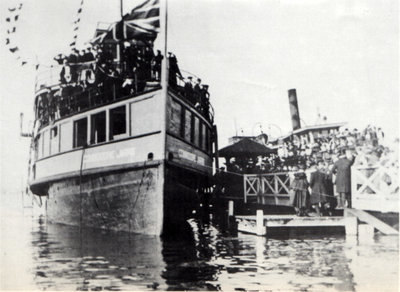
An extremely rare photo from the Howard Collection shows COMMODORE JARVIS and KATHLEEN (right) at the R.C.Y.C. pier. Toronto, on Labour Day, 1917.
As such, it may well be the last photograph ever taken of KATHLEEN, for the 1917 season was her last in service. Like ISLAND QUEEN, she probably would have lasted for about another decade, as did CLARK BROS. and JOHN HANLAN, and she almost certainly would have wound up in the colours of the Toronto Transportation Commission, which operated the ferry service for the City of Toronto after the City bought out the Toronto Ferry Company in December of 1926. But fire was to cut short her life.
Some recent reading of old Toronto newspapers brought Ye Ed. something of a surprise in respect of the demise of ISLAND QUEEN and KATHLEEN. Many historians had believed that the ships had perished on March 12, 1918, in a fire at the Bay Street ferry docks. How wrong we were! In fact, the Bay Street docks were destroyed in a fire which occurred at about 7:00 p.m. on Sunday, January 6, 1918, and the only vessel damaged in that conflagration was the Niagara Navigation Company's beam-engined paddler CHIPPEWA, which was lying along the west side of the wharf, but which was saved by the valiant efforts of all of the Toronto fire brigades which attended the multi-alarm blaze. (This was only one of several disastrous fires which, over the years, beset the city-side ferry docks, and even the Hanlan's Point docks were burned out on at least one occasion.) But when the city docks went down in January of 1918, ISLAND QUEEN and KATHLEEN were nowhere near for, as was the Toronto Ferry Company's custom, the entire ferry fleet had been laid up for the winter at Hanlan's Point, where the firm could do winter maintenance on the steamers and where they were (supposedly) out of the reach of vandals.
The following account of the actual destruction of ISLAND QUEEN and KATHLEEN, which took place at the Hanlan's Point docks early on the morning of Tuesday, March 12, 1918, is taken from "The Toronto Daily Star" of that same date: "The KATHLEEN and ISLAND QUEEN, two small ferries of the Toronto Ferry Company's fleet, valued at $25,000., were totally destroyed by fire at their moorings at Hanlan's Point dock at 4:35 this morning. Both ferries were burnt to the water edge, but the big BLUEBELL, TRILLIUM, MAYFLOWER, PRIMROSE, and the docks were saved by the united efforts of a fire engine crew from the Yonge Street hall and a section of firemen from Adelaide Street. The cause of the fire is unknown. There were no stoves or electric wires on the boats, and the night watchman, Captain John Dunnett, had just made his rounds of inspection some time before the fire was discovered by John Reynolds of the police guard of the (Island water) filtration plant.
"The fire broke out in the KATHLEEN, and in a few minutes she was a mass of fire. The flames leaped to the other side of the dock, where ISLAND QUEEN was tied up, and in a few minutes she was ablaze. An alarm was sent to the city and an engine from Yonge Street and a hose section from Adelaide Street were sent to the scene.
"The engine, weighing four and one-half tons, drawn by two powerful horses, made a wild trip over the Bay. The engine crew were: Engineer Richard Lyons, Stoker Samuel Oliver and Driver William Bolt. The hose section, which went over in a sleigh, was composed of Capt. A. Cochrane, Capt. William Hawkes, Lieut. J. C. Hurst, Firemen Alfred Redsill, John McGregor, David Barnes, Gordon Kyle, Edward Sullivan, and Driver Chris Secrest.
"It was the engine crew that had the trying experience. They went on the Bay at the foot of York Street. After much trouble, the engine was pulled over the mud bank down onto the ice, and for a few minutes it was feared it would go through. It sank a foot in the slush and water till the firebox was a few inches from the surface. Bolt whipped his horses, the big fellows seemed to realize that they had to get to the fire, and they made the trip across the Bay in twelve minutes.
"When they reached the fire, the ferries were a mass of flames, and the firemen turned their efforts to saving the other ferries and the wharves. A hole was chopped through four feet of ice and the suction hose was dropped into the Bay. In a few minutes, Engineer Lyons was able to give 100 pound pressure to the firemen, and with plenty of water they were able to control the fire and save a bad situation. Deputy Chief Russell also went across the Bay in his motor.
"'I don't know the cause of the fire', stated Mr. L. Solman. 'Both boats were valued at $25,000 and they are a total loss, covered by insurance. The firemen did excellent work and saved the wharves and the other boats.'
"'It was some exciting experience', stated Driver Wm. Bolt of the fire engine to The Star. 'We sank into a foot of slush and water when we went on the Bay at York Street, and for a time it looked as if we would go through, but I kept the horses on the move and after we got clear of the shore it was not so bad.'"
The report contained in the March 13, 1918, edition of "The Globe" basically agreed with the report in "The Star". The version printed on March 13 by "The Mail and Empire", however, differed in that it alleged that the fire began on ISLAND QUEEN and spread to KATHLEEN. It also stated that minor damage was suffered by TRILLIUM and BLUEBELL but that all of the other ferries escaped without damage. "The Mail and Empire" also noted that "yesterday afternoon, Detective Walter McConnell was assigned to make a thorough investigation to ascertain if any loungers had been using the boat as a smoking place". Nothing was ever said about the results of the detective's investigation.
The most interesting part of "The Mail and Empire" report was its final paragraph. "Mr. L. Solman stated last evening that work will be begun immediately on the rebuilding of the ISLAND QUEEN, and that he expected the boat will be in commission for the 24th of May. The JASMINE, which has been out of commission for the last three years, will be renovated and made fit to take the place of the KATHLEEN." This is the first we have ever heard to the effect that the famous old JASMINE did not run in 1915, 1916 or 1917; in fact, she ran through to the end of the 1927 season and was burned as a spectacle at Sunnyside Park on August 2, 1929, having failed her inspection in the spring of 1928. It is entirely possible that she had not run for a while, however, and that the loss of the two smaller boats persuaded Lol Solman to reactivate her in 1918.
Needless to say, however, "The Mail and Empire" report was overly optimistic about the prospect of salvaging ISLAND QUEEN, for neither she nor KATHLEEN could be saved. Indeed, each was a total loss, and they simply were cast aside. It is said that their remains were laid to rest in the old lagoon which then existed behind the ferry dock area at Hanlan's Point, and that their bones could be seen there for several years before they disintegrated. That both steamers had been much loved by the people of Toronto was proven by the appearance on the front page of one of the city newspapers (the same edition in which the loss of the ferries was reported on an inside page) of a tearful farewell to both ISLAND QUEEN and KATHLEEN.
Previous Next
Return to Home Port or Toronto Marine Historical Society's Scanner
Reproduced for the Web with the permission of the Toronto Marine Historical Society.